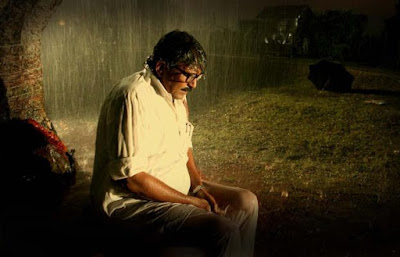By Anirban Lahiri
Featured in IMDb Critic Reviews
 |
| Ek Nadir Galpo - By Samir Chanda |
Our Rating: 1.0
IMDb Ratings: 7.9
Genre: Drama
Cast: Mithun Chakraborty, Nirmal Kumar, Montu Mahapatra
Country: India
Language: Bengali
Runtime: 124 min
Color: Color
Summary: Darakeshwar (Mithun) and Anu (Swetha) are father and daughter. Tragedy strikes as Anu drowns in Keleghai river. Now Darakeshwar's only goal is to rename the river Keleghai as Anjana in memory of his loving daughter.
Samir Chanda’s debut feature film, the Mithun Chakraborty and Shweta Basu Prasad starrer, Ek Nadir Galpo (Tale of A River), is a cinevized Bangla TV serial at best. Neither Samir Chanda nor the director of photography Rajan Kothari is alive today. Else it would have made sense to ask them how they could make such a bad film.
The film was shot in 2007. So far as I know, this was shot on film. The final result, in projection, gives the impression of digibeta colour space (a colour space is an analog-digital description of the different wave-lengths of light in their proportionate separation, gradation and the number of colours represented in a recording/playback/projection/viewing medium. Common sense says, the bigger the colour space the more number of colours that would hold. However, it is not only number of colours that is important for the final relishing of the image. Different media have different colour spaces. How one colour graduates to another is a characteristic feature of the colour space of a particular medium.) The film looks flat and uninteresting on the screen.
 |
| Mithun as the Postmaster or Dakbabu |
The way this is narrated through stereotypes, clichéd dialogues and turn of events, predictable comic reliefs, sentimental score, lacklustre editing and patchy spaces, it makes way for doubt in Samir Chanda’s visual storytelling skill. The film squeaks of lack of budget at every point. But, the structure of the narrative and dialogues do not depend on money. Mithun Chakraborty has been cast in an overused introspective, lost recluse ever since Tahader Katha (1992). Ek Nadir Galpo is the late st attempt at such casting. Shweta Prasad as Anjana is shallow. We have seen scores of such characters in Bengali films since the 1960s. Countless characters portrayed by Sandhya Roy in idyllic set up, such as Palatak (1963), Nimantran (1971), or Aparna Sen in Samapti (1961), has shown the modernist version of that romanticism on the Bengali screen. Anjana’s character, under the tutelage of Samir Chanda, failed to live up to that standard.
 |
| Shweta Prasad as Anjana |
(The film is based on a story by Sunil Gangopadhyay. This review pertains to the film as a distinct creation, and not the story.)
Verdict: You would not miss
anything if you watch this film!
About Author -
About Author -
Anirban is a Cinematographer and film teacher. After a marathon teaching of filmmaking for five years in Digital Academy, Mumbai, he is busy writing his own film now. He was with DearCinema during its first phase. Steeped in cultural theory, observation and history, he sees all his work as part of a continuum – critique. Anirban consciously plays the role of a critic while shooting films, teaching, writing stories, and of course while critiquing. His favourite filmmakers are Sergei Eisenstein, Orson Welles, Jean-Luc Godard, Ritwik Ghatak, Satyaji Ray, Luis Buñuel, Andrei Tarkovsky, Abbas Kiarostami and Nagisa Oshima, to name a few.
Readers, please feel free to share your views/opinions in the comment box below. As always your feedback is highly appreciated!
Ek Nadir Galpo Trailer (YouTube)
Readers, please feel free to share your views/opinions in the comment box below. As always your feedback is highly appreciated!
References:
Ek Nadir Galpo Trailer (YouTube)
People who liked this also liked...



0 comments:
Post a Comment
Thanks for sharing for valuable opinion. We would be delighted to have you back.